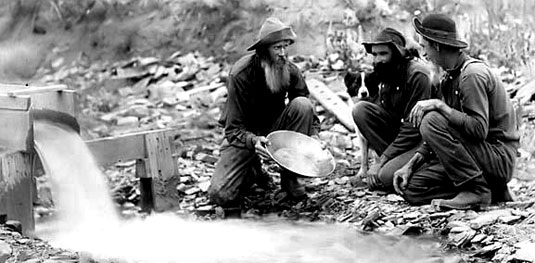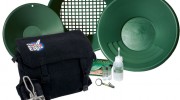
Gold Panning
Gold panning technique
Use the Mighty Eagle Gold Panning kit to help you find treasure! We use plastic pans instead of metal pans because they are lighter, have shallower angles (which means less gold is thrown out of the pan), and because gold is easier to spot against plastic.
- Before you begin, make sure it ok to prospect in the area you are searching. Make sure you have permission from the landowner or mineral rights owner.
- Choose your location along a river or stream to pan. Places where the water slows down, such as behind large rocks, tree roots or sand bars are usually good places for panning.
- Collect sand from the side of the river and run it through the sieve first to get rid of larger particles before placing it in your gold pan.
- Fill the pan almost to the top with sand from the edge of the river. Try sand from various depths. Use the trowel in your kit to dig deeper if you need to.
- Dip the pan’s edge into the stream and fill it with water.
- Hold the pan with one hand and swirl it to mix the sand. Any gold will start settling toward the bottom of the pan.
- Swirl the pan faster. You will lose some of the water along with lighter particles of sand as you go.
- Begin scraping the top sand out of the pan with your free hand.
- Continue until much of the pan is empty, leaving only small bits of gold – if you’re lucky – in a little water.
- Use the tweezers or the pipette to retrieve tiny gold particles and pick out larger samples with your fingers.
- Keep all the gold samples in the plastic vials from your kit.
Look out for Pyrite, or fool’s gold. It looks like the real thing but has no value. There’s lots of it out there, and it’s fun to find even though it won’t make you rich.
To make sure you’ve found gold and not fool’s gold, rub the stone against something white, like porcelain. If it leaves a black streak, it’s fool’s gold. If it leaves a yellow streak, it’s gold. Gold is also much softer than fool’s gold.
Gold can be found farther downstream from its usual source after heavy rains, since the rush of water dislodges it and carries it away.
If you are interested in Gold Panning, you might be interested in this:

Gold Panning Kit
Gold Panning Kit
The Mighty Eagle Gold Panning Kit has everything you need to find gold in our rivers and streams.
Simple chores like taking the dog out for a walk, can become gold finding expeditions. The kit has a fully researched and full colour instruction leaflet to help you. More Info
Date: May 1, 2012 by Ben R

Gold Panning
Gold panning technique
Use the Mighty Eagle Gold Panning kit to help you find treasure! We use plastic pans instead of metal pans because they are lighter, have shallower angles (which means less gold is thrown out of the pan), and because gold is easier to spot against plastic.
- Before you begin, make sure it ok to prospect in the area you are searching. Make sure you have permission from the landowner or mineral rights owner.
- Choose your location along a river or stream to pan. Places where the water slows down, such as behind large rocks, tree roots or sand bars are usually good places for panning.
- Collect sand from the side of the river and run it through the sieve first to get rid of larger particles before placing it in your gold pan.
- Fill the pan almost to the top with sand from the edge of the river. Try sand from various depths. Use the trowel in your kit to dig deeper if you need to.
- Dip the pan’s edge into the stream and fill it with water.
- Hold the pan with one hand and swirl it to mix the sand. Any gold will start settling toward the bottom of the pan.
- Swirl the pan faster. You will lose some of the water along with lighter particles of sand as you go.
- Begin scraping the top sand out of the pan with your free hand.
- Continue until much of the pan is empty, leaving only small bits of gold – if you’re lucky – in a little water.
- Use the tweezers or the pipette to retrieve tiny gold particles and pick out larger samples with your fingers.
- Keep all the gold samples in the plastic vials from your kit.
Look out for Pyrite, or fool’s gold. It looks like the real thing but has no value. There’s lots of it out there, and it’s fun to find even though it won’t make you rich.
To make sure you’ve found gold and not fool’s gold, rub the stone against something white, like porcelain. If it leaves a black streak, it’s fool’s gold. If it leaves a yellow streak, it’s gold. Gold is also much softer than fool’s gold.
Gold can be found farther downstream from its usual source after heavy rains, since the rush of water dislodges it and carries it away.
If you are interested in Gold Panning, you might be interested in this:

Gold Panning Kit
Gold Panning Kit
The Mighty Eagle Gold Panning Kit has everything you need to find gold in our rivers and streams.
Simple chores like taking the dog out for a walk, can become gold finding expeditions. The kit has a fully researched and full colour instruction leaflet to help you. More Info
Related Posts
Panning for goldHow to pan for gold Here is the Mighty Eagle guide to finding gold. Believe…
-
-
May 1, 2012 | Treasure hunting | No comment







